Ekambareswarar Temple: 1st Prithvi Lingam
Ekambareswarar Temple, also known as Ekambaranathar Temple, is a Hindu temple dedicated to the deity Shiva, located in the town of Kanchipuram in Tamil Nadu, India. It is significant to the Hindu sect of Shaivism as one of the temples associated with the five elements, the Pancha Bhoota Stalas, and specifically the element of earth, or Prithvi. Shiva is worshiped as Ekambareswarar or Ekambaranathar or Rajlingeswaram, and is represented by the lingam, with his idol referred to as Prithvi lingam. His consort Parvati is depicted as Elavarkuzhali.
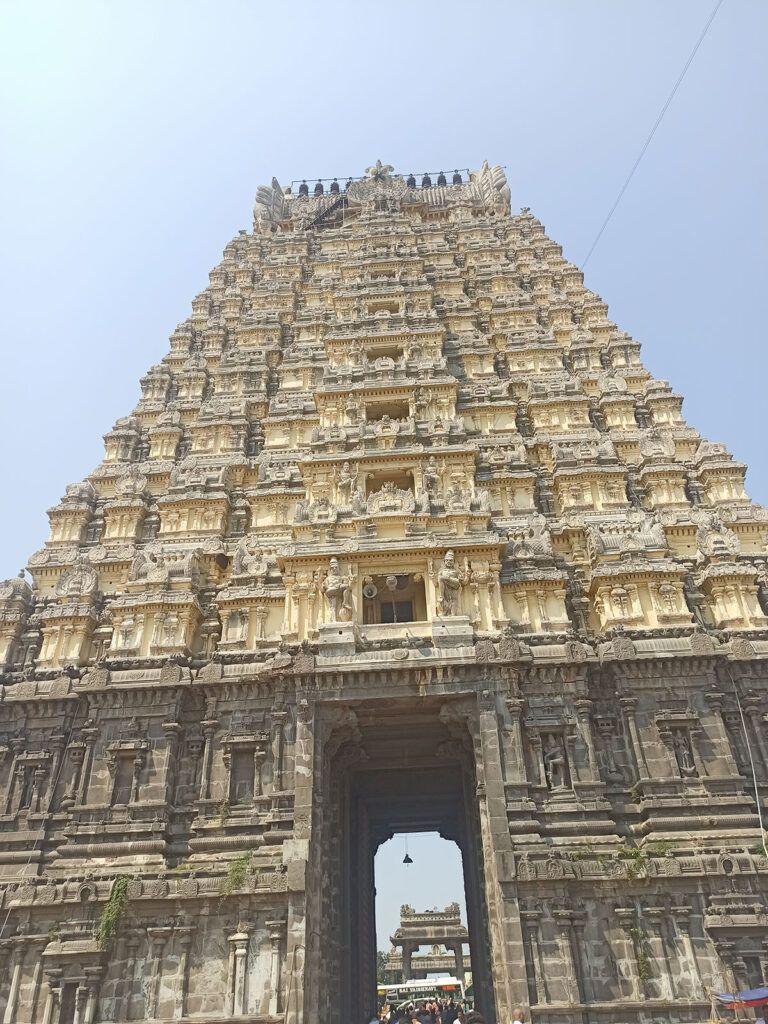
Contents
- 1 History of Ekambareswarar Temple:
- 2 Legend of Ekambareswarar Temple:
- 3 Significance of Ekambareswarar Temple:
- 4 Ekambareswarar Temple Timing:
- 5 Architecture of Ekambareswarar Temple:
- 6 Places to visit near Ekambareswarar Temple:
- 7 Mango Tree in Ekambareswarar Temple:
- 8 FAQ:
- 9 How to reach Ekambareswarar Temple Kanchipuram:
- 10 Google Maps:
History of Ekambareswarar Temple:
The origins of the temple are shrouded in legend and mythology. It is believed that the temple has existed since at least the 6th century CE, and some legends suggest that it may be even older. The first recorded mention of the temple is found in the Tamil epic, “Silappatikaram,” which dates back to the 5th century CE.
The temple was built and expanded by various dynasties over the centuries. The Pallava dynasty is credited with building the earliest structures of the temple, while the Cholas and the Vijayanagara Empire made significant contributions to its expansion and beautification.
The temple complex is spread over 25 acres and is enclosed by a massive outer wall. It houses a 1,000-pillared hall, known as the Rajagopuram, which is one of the largest and most impressive such halls in India. The temple also has a sacred mango tree, which is believed to be over 1,000 years old.
Legend of Ekambareswarar Temple:
According to legend, the temple was originally built by Lord Shiva himself, who manifested as a mango tree lingam to bless the sage Kanchipuram Muni. The sage was a great devotee of Shiva and had been performing penance for many years. Shiva was pleased with the sage’s devotion and appeared before him in the form of a mango tree lingam. The sage worshipped the lingam for many years, and eventually attained moksha (liberation from the cycle of birth and death).
Another legend associated with the temple is that Lord Vishnu once took the form of the Moon and cooled the mango tree lingam with its rays. This happened when Parvati, the consort of Shiva, was performing penance under the tree. Shiva, in order to test her devotion, sent fire to burn the tree. Parvati was in great distress and prayed to her brother Vishnu for help. Vishnu, who was touched by her devotion, took the form of the Moon and cooled the tree with its rays.
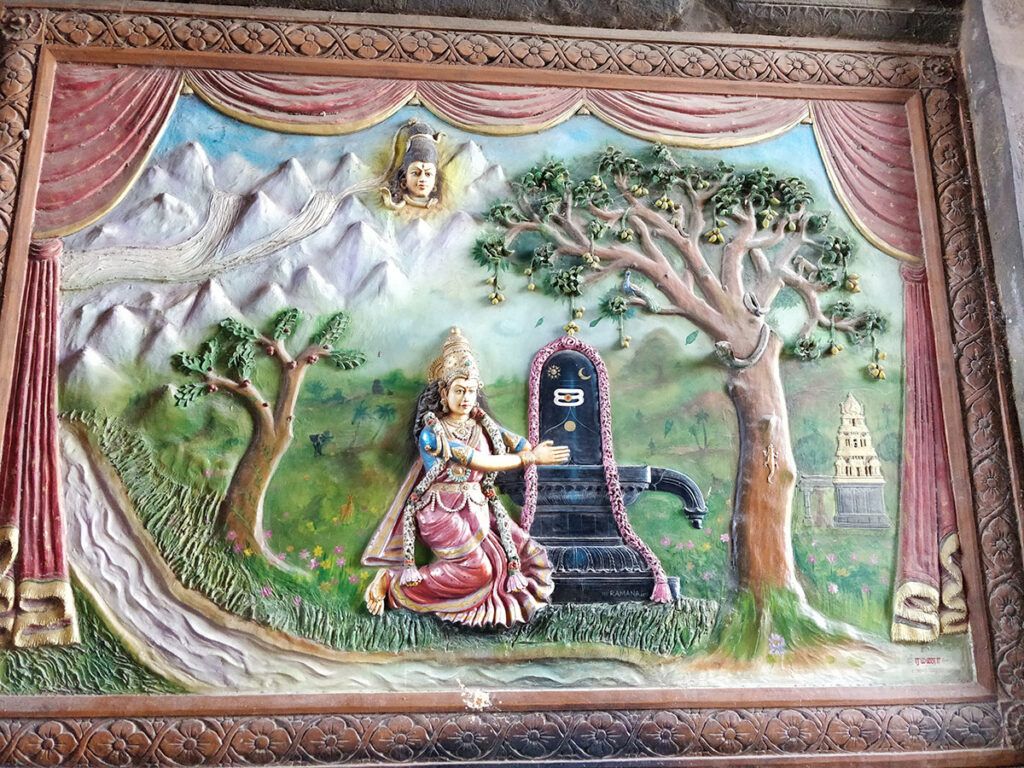
Significance of Ekambareswarar Temple:
- Pancha Bhoota Stalam: The Ekambareswarar Temple is one of the five Pancha Bhoota Stalas, temples dedicated to Lord Shiva, each representing one of the five primary elements of nature: earth, water, fire, air, and sky. The Ekambareswarar Temple specifically represents the element of earth, or Prithvi. This association with the earth element is further reinforced by the fact that the lingam, the symbol of Shiva, enshrined in the temple is made of earth.
- Legend and Mythology: The temple is associated with a fascinating legend involving Lord Shiva and his consort, Goddess Parvati. According to the legend, Parvati, seeking to win Shiva’s love, performed intense penance under a mango tree in this sacred grove. To test her devotion, Shiva sent a fiery inferno to consume the grove. Parvati, undeterred, embraced the lingam, protecting it from the flames. Impressed by her unwavering devotion, Shiva appeared before her and married her. The mango tree under which Parvati performed her penance is still revered in the temple complex.
- Architectural Grandeur: The Ekambareswarar Temple is a marvel of Dravidian architecture, showcasing intricate carvings, towering gopurams (gateway towers), and spacious courtyards. The temple complex covers a vast area of 23 acres and is enclosed by a massive outer wall. The temple’s intricate carvings depict various scenes from Hindu mythology, adding to its spiritual and cultural significance.
- Spiritual Eminence: The Ekambareswarar Temple is considered one of the most important and revered Shiva temples in India. Devotees from all over the country flock to the temple to seek blessings and offer prayers to Lord Shiva. The temple’s sacred atmosphere and the presence of the revered Prithvi Lingam make it a pilgrimage site for Hindus seeking spiritual enlightenment and divine grace.
- Cultural Heritage: The Ekambareswarar Temple has played a significant role in shaping the cultural heritage of Kanchipuram and Tamil Nadu. The temple has been a center of religious and cultural activity for centuries, hosting numerous festivals and celebrations throughout the year. The temple’s architecture, art, and traditions have inspired generations of artists, poets, and musicians, contributing to the rich cultural tapestry of the region.
Ekambareswarar Temple Timing:
The Ekambareswarar Temple in Kanchipuram, Tamil Nadu, India, is open to visitors from 6:00 AM to 12:30 PM and again from 4:00 PM to 8:30 PM. These timings are subject to change during special festivals and occasions. It is advisable to check with the temple authorities or visit their official website for the most up-to-date timings.
Here’s a breakdown of the temple’s timings:
Morning Timings:
- Opening: 6:00 AM
- Closing: 12:30 PM
Evening Timings:
- Opening: 4:00 PM
- Closing: 8:30 PM
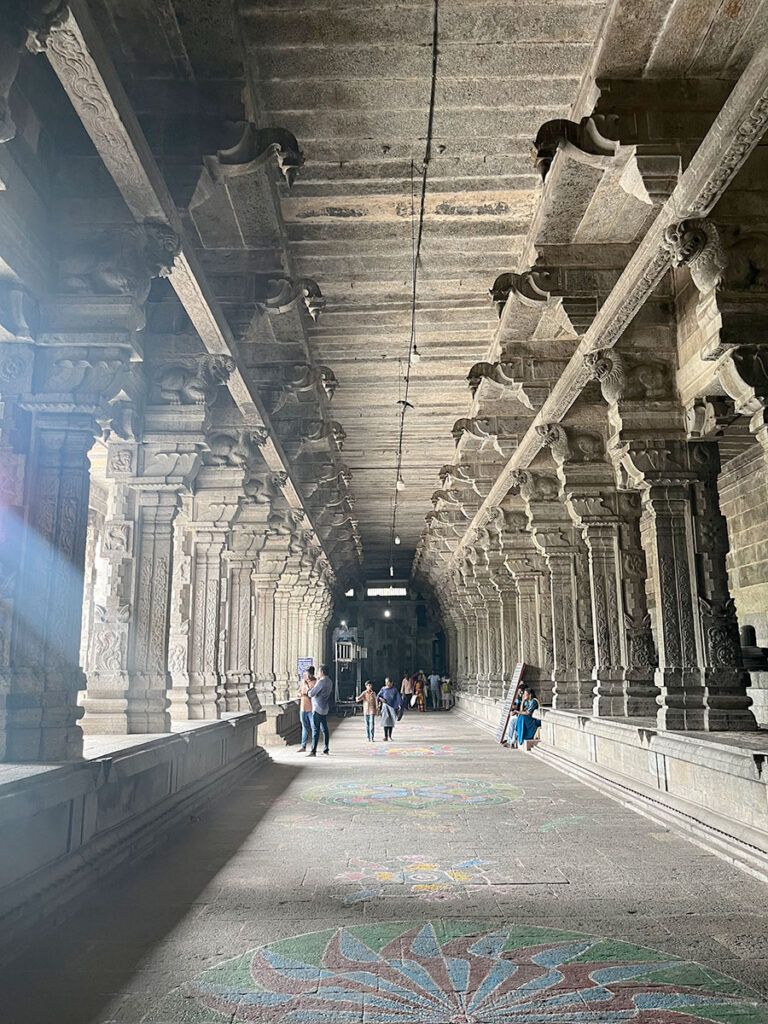
Architecture of Ekambareswarar Temple:
Gopurams (Entrance Towers): The temple has several impressive gopurams, which are towering entrance structures adorned with intricate sculptures and carvings. The Rajagopuram, the main entrance tower, is particularly notable for its architectural grandeur.
Mandapams (Halls): The temple complex includes various mandapams or halls, each serving a specific purpose. These halls are often adorned with beautiful sculptures and carvings depicting various mythological stories.
Pillars and Columns: The temple is renowned for its numerous intricately carved pillars and columns. The sculptural work on these pillars showcases exquisite craftsmanship and often depicts scenes from Hindu mythology.
Prakarams (Enclosures): The temple has several prakarams or enclosures that house various shrines and structures. Each prakaram is designed with a specific layout and has its own significance.
Pond and Gardens: Ekambareswarar Temple is known for its large temple tank (pond) called Sivaganga, which is believed to have healing properties. The temple also has well-maintained gardens, adding to the overall aesthetic appeal of the complex.
Sannidhis (Sanctums): The main sanctum of the temple houses the presiding deity, Lord Shiva, in the form of Ekambareswarar. There are also shrines dedicated to other deities within the temple complex.
Vimanam (Tower above Sanctum): The vimanam is the tower above the sanctum sanctorum, and it is often adorned with intricate sculptures and carvings. The vimanam of Ekambareswarar Temple is a significant element of its architecture.
Festive Hall: The temple has a festive hall where various ceremonies and festivals are conducted. The hall may have unique architectural features and is designed to accommodate a large number of devotees during special events.
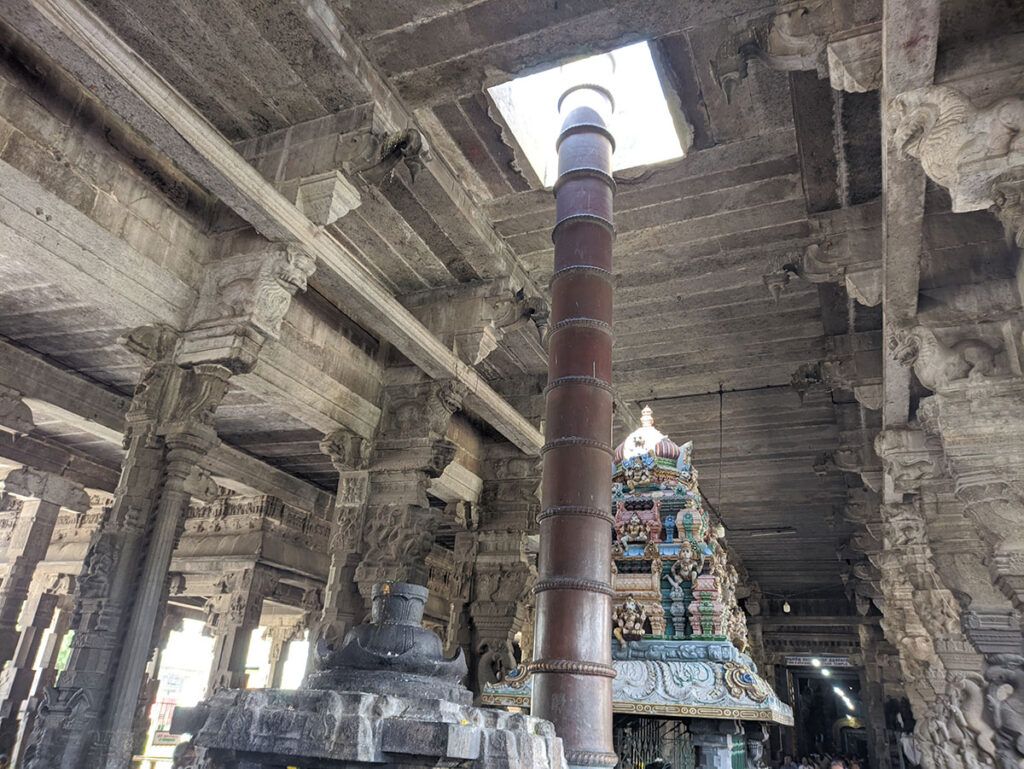
Places to visit near Ekambareswarar Temple:
Mahamaham Tank: This sacred tank is located in the heart of Kumbakonam and is associated with the Mahamaham festival that takes place once every 12 years. The tank is surrounded by several temples and ghats.
Sarangapani Temple: It is one of the Divya Desams, dedicated to Lord Vishnu, and is located in Kumbakonam itself. The temple is known for its intricate architecture and beautiful sculptures.
Chakrapani Temple: Another prominent Vishnu temple in Kumbakonam, dedicated to Lord Chakrapani. The temple is known for its idol of Lord Vishnu holding a chakra (discus).
Kasi Viswanathar Temple: This temple is dedicated to Lord Shiva and is known for its unique architecture. It is believed to be one of the Pancha Bhoota Stalams, representing the element of water.
Nageswaran Temple: Located in Kumbakonam, this temple is dedicated to Lord Shiva and is known for its architectural beauty and intricate carvings.
Adi Kumbeswarar Temple: Another significant Shiva temple in Kumbakonam, it is one of the Saivaite Pancha Krosha Sthalas and is associated with the Mahamaham festival.
Uppiliappan Temple: Located in Thirunageswaram, near Kumbakonam, this temple is dedicated to Lord Vishnu and is known for its unique deity of Uppiliappan.
Swamimalai Murugan Temple: Situated near Kumbakonam, this temple is one of the Arupadaiveedu dedicated to Lord Murugan. It is situated atop a hill and is known for its historical significance.
Darasuram Airavatesvara Temple: A UNESCO World Heritage Site, this temple is renowned for its Chola architecture and intricate carvings. It’s located a bit farther from Kumbakonam but is worth a visit.
Kumbakonam Arts and Science College: If you’re interested in cultural and historical artifacts, you might want to visit this college’s museum, which houses a collection of sculptures and artifacts.
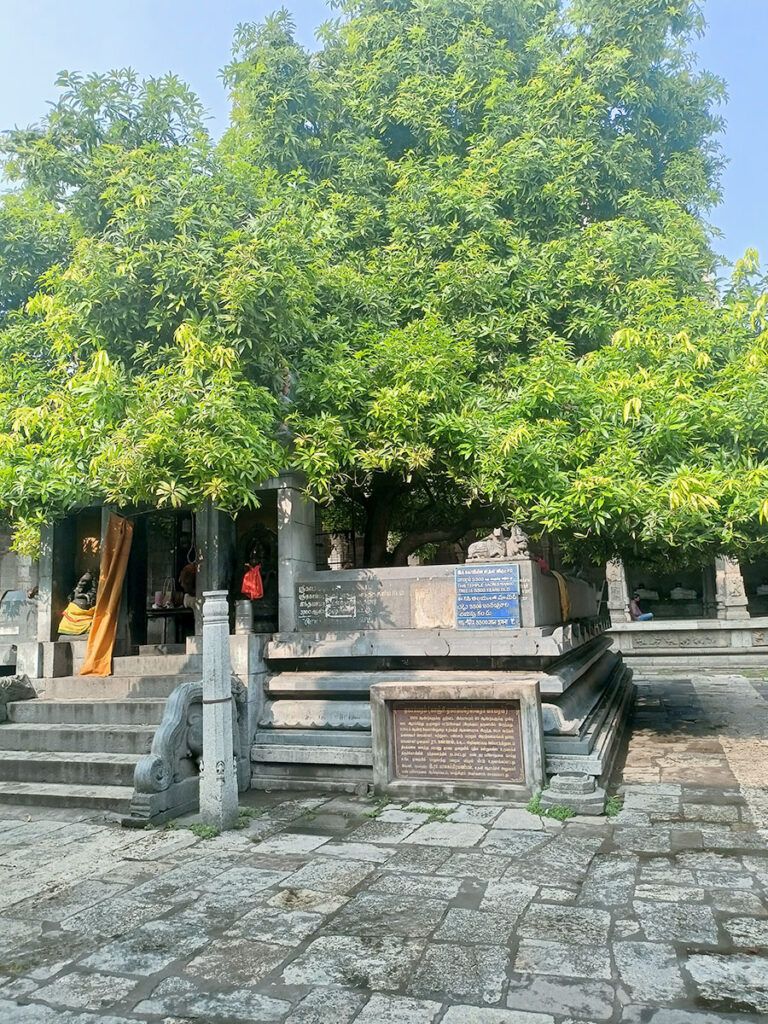
Mango Tree in Ekambareswarar Temple:
The ancient mango tree in the Ekambareswarar Temple is a venerated symbol of the temple’s sacred nature and is intricately interwoven with the temple’s legends and mythology. Revered as the ‘sthala-virutcham’ or temple tree, it is estimated to be over 3,500 years old, bearing witness to the temple’s transformation through the ages.
A Symbol of Parvati’s Devotion
Legend has it that the mango tree was the sacred spot where Goddess Parvati performed unwavering penance to win Lord Shiva’s affection. Under the tree’s protective canopy, she sought spiritual enlightenment and demonstrated her unwavering dedication to her love. The tree’s presence provided Parvati with shade and shelter during her spiritual quest, making it an enduring symbol of her devotion and Shiva’s eventual acceptance of her love.
Representing the Four Vedas
The mango tree is also imbued with symbolic significance, representing the four Vedas, the sacred scriptures of Hinduism. It is believed that each of the tree’s four branches bears a distinct variety of mango, each symbolizing one of the four Vedas: Rig Veda, Yajur Veda, Sama Veda, and Atharva Veda. This association with the Vedas further reinforces the tree’s spiritual significance, aligning it with the divine wisdom enshrined in these ancient texts.
A Source of Blessings and Healing
Devotees hold the mango tree in high esteem, believing it possesses mystical powers and that its leaves and fruits hold healing properties. They often offer prayers and offerings to the tree, seeking blessings and divine grace. The tree’s presence in the temple complex adds a touch of mysticism and serenity, creating a space for spiritual solace and inspiration.
A Living Testimony to the Temple’s Legacy
The mango tree stands as a living testament to the Ekambareswarar Temple’s enduring legacy and the unwavering faith of its devotees. Its presence has become an integral part of the temple’s identity, symbolizing the temple’s sacred nature, the unwavering devotion of its devotees, and the enduring power of faith and spirituality.
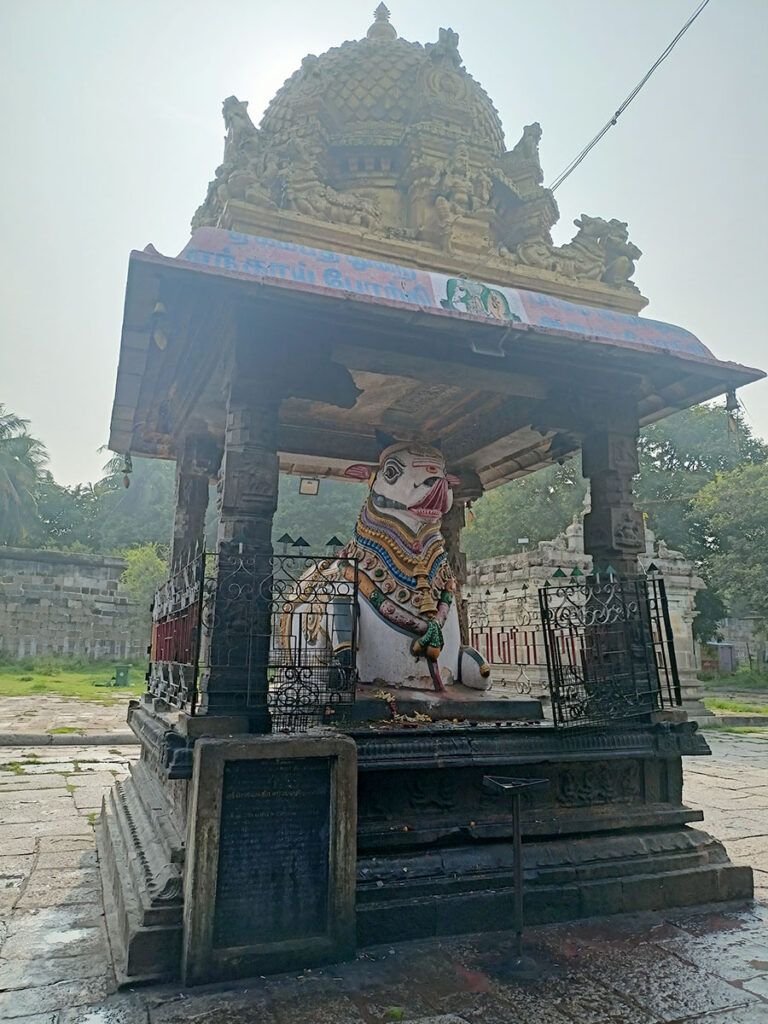
FAQ:
Where is the Ekambareswarar Temple located?
The Ekambareswarar Temple is located in the town of Kanchipuram, Tamil Nadu, India. It is about 70 kilometers (43 miles) southwest of Chennai, the capital of Tamil Nadu.
What are the festivals celebrated at the Ekambareswarar Temple?
The Ekambareswarar Temple hosts numerous festivals and celebrations throughout the year. The most important festival is the Maha Shivaratri festival, which is celebrated every year in February or March. This festival marks the night of Shiva’s wedding to Parvati. Other important festivals include the Navaratri festival, the Karthigai Deepam festival, and the Aani Thirukalyanam festival.
Where is Prithvi Lingam?
The Prithvi Lingam is located in the Ekambareswarar Temple (also known as the Ekambaranathar Temple) in Kanchipuram, Tamil Nadu, India. It is enshrined in the sanctum sanctorum of the temple, which is accessible to Hindu devotees.
The Prithvi Lingam is a unique lingam made of earth, representing the element of Prithvi, one of the five primary elements of nature in Hinduism. It is said to have been created by Goddess Parvati as a symbol of her devotion to Lord Shiva. The Prithvi Lingam is considered to be one of the most sacred lingams in Hinduism and is revered by pilgrims from all over India.
What are the 5 Lingas?
The five Lingas are:
- Prithvi Lingam: This Lingam represents the element of earth and is located in the Ekambareswarar Temple in Kanchipuram, Tamil Nadu, India.
- Jambukeshwarar Lingam: This Lingam represents the element of water and is located in the Jambukeswarar Temple in Thiruvarur, Tamil Nadu, India.
- Arunachaleswarar Lingam: This Lingam represents the element of fire and is located in the Arunachaleswara Temple in Tiruvannamalai, Tamil Nadu, India.
- Kalahastheeswara Lingam: This Lingam represents the element of air and is located in the Srikalahasti Temple in Srikalahasti, Andhra Pradesh, India.
- Nataraja Lingam: This Lingam represents the element of ether and is located in the Thillai Nataraja Temple in Chidambaram, Tamil Nadu, India.
What is the Speciality of Ekambareswarar temple?
- Massive Temple Complex: Ekambareswarar Temple is one of the largest temples in Kanchipuram, covering a vast area. The complex includes several halls, shrines, and towers.
- Ancient History: The temple has a rich history and is believed to have been in existence since at least the early medieval period. The original structure is said to have been built by the Pallava kings, with subsequent contributions and expansions by the Chola and Vijayanagara dynasties.
- Pancha Bhoota Stala: The temple is dedicated to Lord Shiva, representing the element of Earth (Prithvi). Each of the Pancha Bhoota Stalas is associated with a specific element, and in Ekambareswarar Temple, it is the Earth element.
- Prithvi Lingam: The presiding deity in the form of the lingam (an abstract representation of Shiva) is known as Prithvi Lingam, symbolizing the Earth. The lingam is made of sand, and it is believed that worshipping it can bestow prosperity.
- Massive Mango Tree: One of the unique features of the temple is the presence of a centuries-old mango tree in the temple complex. According to legend, the goddess Parvati, in the form of a cow, worshipped Shiva under this mango tree. The tree is said to produce four different types of mangoes, representing the four Vedas.
- Thousand Pillar Hall: The temple houses a Thousand Pillar Hall, known as “Aayiram Kaal Mandapam,” which is an architectural marvel. The hall is adorned with intricate sculptures and carvings.
- Festivals: The temple celebrates various festivals, including the annual Panguni Uthiram festival, which is of great significance. During this festival, the marriage of Shiva and Parvati is reenacted, and it attracts a large number of devotees.
- Architectural Beauty: The temple showcases Dravidian architecture with its towering gopurams (entrance towers), intricate sculptures, and well-designed halls.
How to reach Ekambareswarar Temple Kanchipuram:
By Air:
The nearest airport to Kanchipuram is Chennai International Airport (MAA). From the airport, you can hire a taxi or use other transportation options to reach Kanchipuram.
By Train:
The nearest railway station is Kanchipuram Railway Station. You can take a train to Kanchipuram from Chennai or other nearby cities. From the railway station, you can hire an auto-rickshaw or a taxi to reach Ekambeswarar Temple.
By Bus:
Kanchipuram is well-connected by road. You can take a bus from Chennai or other nearby cities to Kanchipuram. Once you reach the Kanchipuram bus stand, you can hire a local transport option to reach the temple.
By Car:
If you are driving, you can use GPS navigation or follow the road signs to reach Kanchipuram. The temple is a prominent landmark in the city, and locals can guide you to its location.
Local Transportation:
Once you reach Kanchipuram, you can use auto-rickshaws, cycle rickshaws, or taxis to navigate within the city and reach the Ekambeswarar Temple.
